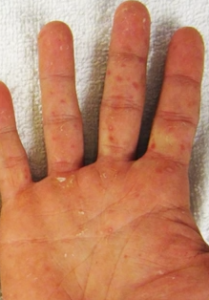Symptoms of red palms
Red palms may occur with the below listed signs and symptoms:
- The intensity of red color of palms is dependent on hand elevation, pressure exerted on palms, the temperature of the hand or palm, and the emotional state of affected person
- The skin of affected palms may elicit warmth
- There is no itchiness, pain, and flaky or scaly skin on palms
- Redness of palms usually affects the hypothenar eminence area. In some cases, the thenar eminence region and fingers may also experience redness
- Red palms may occur simultaneously with red soles; reddish soles of feet is medically termed as plantar erythema.
Causes of red palms
The condition of red palms is grouped into two types, as mentioned below:
- Primary palmar erythema: This form of PE occurs on its own and there are usually no underlying conditions or causative factors. In some cases, the condition may be genetic or hereditary. Idiopathic red palms where the underlying cause is unknown or medical experts are still trying to find the exact cause, is also classified as primary PE. About 50% of red palms cases are of this type.
- Secondary palmar erythema: This form of PE occurs as a symptom of some causative pre-existing condition. A few common causes are listed below:
- Pregnancy: It is one of the most prevalent causes of red palms. Circulatory system changes, increase in hormones like estrogen, and other body alterations occur during pregnancy. Such changes may lead to reddish palms. Hormonal changes cause skin alterations in nearly 30% of expectant mothers.
- Rheumatological conditions: Rheumatoid arthritis and lupus, etc. may cause secondary PE, but the specific association between rheumatoid arthritis is not known. Red palms are however observed in about 60% of patients.
- Liver problems: Hereditary haemochromatosis, hepatitis, liver cirrhosis, and Wilson’s disease, etc. are different conditions of the liver that cause red palms. Persistent liver disease is characterized by abnormal levels of estrogen and oestradiol hormones. Liver problems may also be accompanied by arteriovenous anastomoses dysfunction.
- Thyroid issues: Estradiol levels may rise abnormally due to thyroid disorders like hyperthyroidism and thyrotoxicosis, etc., thereby causing reddish palms
- Growing tumors: Malignant tumors associated with cancers like leukemia, brain cancer, liver cancer, etc., may trigger abnormal rise in estrogen levels, thereby causing the palms to attain a reddish hue
- Diabetes mellitus: Red palms that are hot or warm to touch may be observed in diabetics. In some cases red spots on palms may be seen instead of reddish palms.
- Shoulder-hand syndrome: In this, patients suffer from problems of the upper body extremities, red palms, and pain and stiffness of hand, fingers, and shoulders. The condition is also called reflex sympathetic dystrophy.
- Certain medicines: Red palms may occur as a side effect of using medicines like bile acid sequestrant drug cholestyramine; gemfibrozil drug taken for reducing lipid levels; anti-asthma medicine called albuterol which is recommended for broncho-spasms; anti-arrhythmia agent amiodarone; and anticonvulsant drug called topiramate. Oral contraceptives can cause a sudden rise in levels of estrogen hormone and trigger red palms.
- Chronic alcohol abuse: Alcoholism for a prolonged period can cause liver problems, abnormal levels of estrogen and oestradiol, and red palms
- Prolonged mercury poisoning: Chronic exposure to mercury or may result in occurrence of neurological and cutaneous adverse effects, and increased redness of the palms is one such abnormal symptom.
- Sarcoidosis: This disease is characterized by inflammation of different body systems and varied symptoms, including red palms.
- Myelopathy: It is a degenerative disorder. Patients suffer from adverse symptoms like pinched spinal column, circulatory defects, and redness of the palms, etc.
- Gestational syphilis: Infection by syphilis virus during pregnancy can cause red palms amongst a host of other symptoms.
- Other causes: Red palms may also occur due to:
- Chronic smoking for many years can cause circulatory system problems in the hands and other body areas.
- Sometimes, inherited diseases may be marked by red palms
- Polycythemia vera, a type of circulatory condition
- Dysfunction of the adrenal glands.
Treatment of red palms
Primary type of red palms need not be medically treated. Secondary PE treatment is carried out as per the underlying causative condition.
- Corticosteroids, painkillers, and other medications are used for treatment of autoimmune conditions
- Thyroid problems are treated with iodine, anti-thyroid medications, or surgery in severe cases
- Eating a balanced and healthy diet, quitting smoking, restricting alcohol intake, exercising, and other lifestyle changes can help prevent illnesses that trigger red palms.
